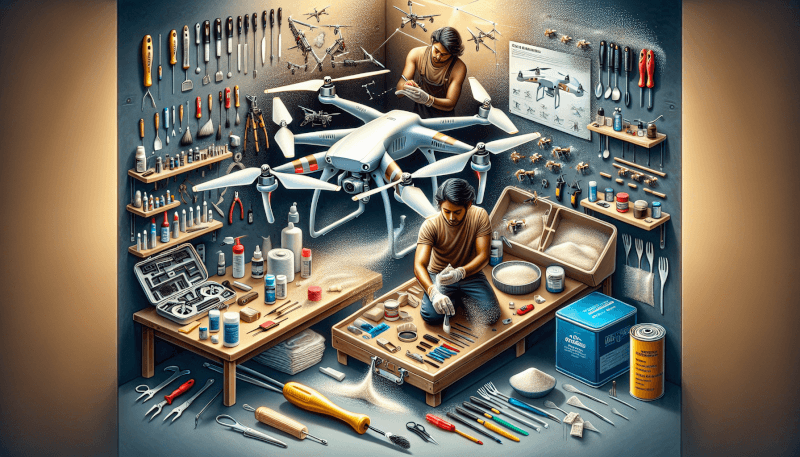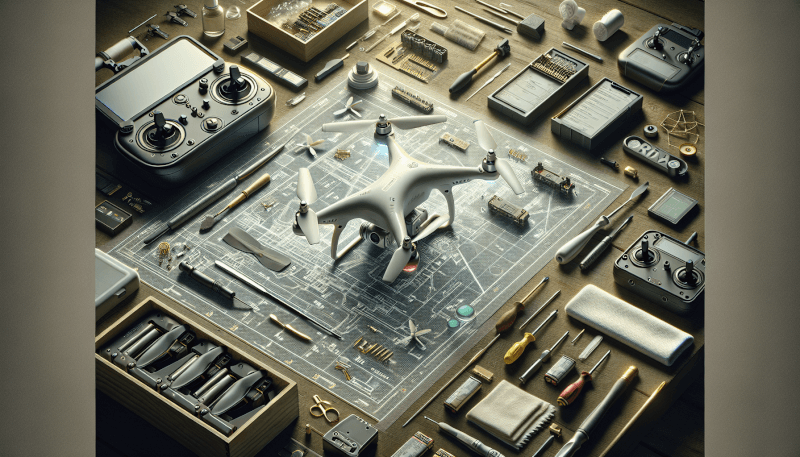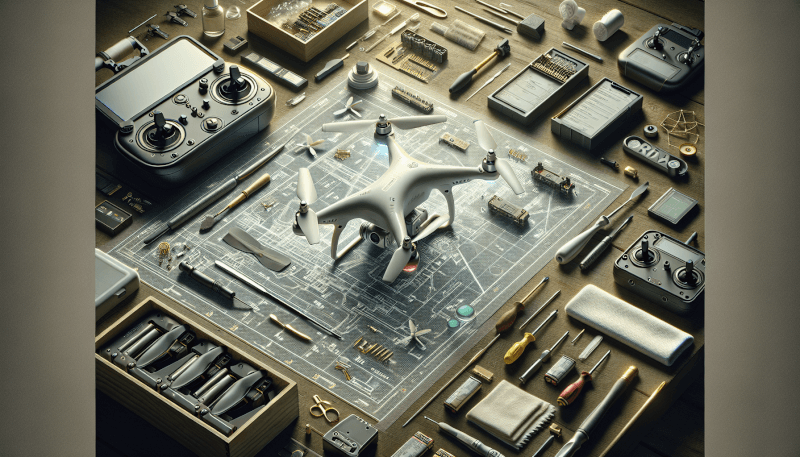Taking care of your drone is an important aspect of being a responsible drone owner. From regular maintenance to proper flight procedures, there are several essential tips that can help ensure that your drone remains in top condition and continues to provide you with amazing aerial footage. In this article, we will explore these tips in detail, providing you with valuable information on how to protect your investment and enjoy your drone for years to come. So, whether you are a seasoned drone pilot or a beginner, read on to discover the essential tips that will help you take care of your drone like a pro.

1. Pre-flight Maintenance
1.1 Cleaning the Drone
Before every flight, it is important to clean your drone to ensure optimal performance. Start by removing any dust, dirt, or debris from the body of the drone using a soft brush or microfiber cloth. Pay extra attention to the motor and propeller areas, as they tend to accumulate dirt and dust. If necessary, use a mild cleaning solution and a cotton swab to gently clean the nooks and crannies of the drone. Make sure to dry the drone thoroughly before moving on to the next step.
1.2 Checking Battery Levels
One of the most crucial steps in pre-flight maintenance is checking the battery levels of your drone. Before taking off, ensure that the batteries are adequately charged to avoid unexpected power loss during flight. Use the manufacturer’s recommended charger and monitor the charging process to prevent overcharging. It is also a good practice to have spare batteries on hand, especially for longer flights or when shooting videos that require extended flight time.
1.3 Inspecting Propellers
Inspecting the propellers is essential to ensure smooth and safe flights. Make sure there are no visible signs of damage, such as cracks or bends. Additionally, check for any debris that may have gotten tangled in the propellers. Keeping the propellers in good condition not only enhances your drone’s performance but also reduces the risk of accidents or propeller failure during flight.
1.4 Verifying Firmware
Regularly updating your drone’s firmware is crucial to maintain its performance and functionality. Check for firmware updates from the manufacturer and follow their instructions to ensure that your drone is running on the latest software version. Firmware updates often include bug fixes, improvements in stability, and new features. By keeping your drone’s firmware up to date, you can maximize its potential and enhance your flying experience.
1.5 Calibrating Sensors
To ensure accurate and reliable flight, it is important to calibrate your drone’s sensors. Sensor calibration helps the drone maintain stability, accurately measure altitude, and respond to flight commands effectively. Follow the manufacturer’s instructions to calibrate the drone’s compass, accelerometer, and gyroscope. It is recommended to calibrate the sensors in an open area away from any magnetic interference, such as metal objects or power lines.
2. Safe Flying Practices
2.1 Checking Weather Conditions
Prior to every flight, check the weather conditions to ensure safe flying. Avoid flying in strong winds, rain, or foggy conditions, as they can affect the stability and performance of your drone. High winds can make it difficult to control the drone, while rain and fog can damage the electronics. Always prioritize safety and choose calm and clear weather for your flights.
2.2 Finding Suitable Flying Locations
Selecting suitable flying locations is essential for both your flight experience and the safety of those around you. Look for areas away from crowded and congested spaces, such as parks or open fields, where you can fly your drone without posing any risk to people or property. Be mindful of any restricted airspace or local regulations that prohibit flying in specific areas.
2.3 Avoiding No-Fly Zones
It is crucial to familiarize yourself with the designated no-fly zones in your area. No-fly zones are areas where flying drones is prohibited due to safety or security reasons, such as airports, military bases, or government buildings. Utilize smartphone apps or online resources to check for any restricted airspace or temporary flight restrictions in your intended flying location. By adhering to these restrictions, you ensure the safety of both your drone and the surrounding environment.
2.4 Maintaining Visual Line of Sight
As a responsible drone operator, it is important to maintain a clear visual line of sight with your drone. Keep your drone within your line of sight at all times to avoid collisions with obstacles or other aircraft in the vicinity. Maintaining visual contact allows you to monitor the drone’s position, altitude, and surroundings, ensuring safe and controlled flights.
2.5 Observing Drone Laws and Regulations
To fly your drone safely and legally, it is essential to understand and follow the drone laws and regulations in your country or region. Familiarize yourself with the specific rules and guidelines regarding drone registration, pilot certifications, flight restrictions, and privacy considerations. Adhering to these laws not only ensures the safety of others but also avoids legal consequences and penalties.

3. Battery Management
3.1 Charging and Storing Batteries Properly
Proper battery management is crucial for the longevity and performance of your drone’s batteries. Follow the manufacturer’s guidelines for charging your batteries and use the provided charger or a recommended third-party charger. Avoid overcharging or leaving the batteries unattended while charging. When storing your drone, make sure to remove the batteries and store them in a cool, dry place away from direct sunlight or extreme temperatures.
3.2 Monitoring Battery Health
Regularly monitor the health of your drone’s batteries to ensure they are in optimal condition. Many drones have built-in battery management systems that provide information such as voltage, temperature, and overall battery health. Pay attention to any signs of battery degradation, such as decreased flight time or abnormal behavior. If you notice any issues, consider replacing the battery to maintain reliable performance.
3.3 Avoiding Over-Discharging
Over-discharging your drone’s batteries can significantly reduce their lifespan and potentially lead to battery failure. Most drones have safety mechanisms that prevent over-discharging, but it is still important to keep an eye on the battery levels during flight. If the battery voltage drops below a certain threshold, the drone will initiate an automatic return to home function. It is advisable to land your drone as soon as the battery level reaches a safe limit to avoid damaging the batteries.
3.4 Using Genuine Batteries
Using genuine batteries recommended by the manufacturer is essential for the safety and performance of your drone. Genuine batteries are designed specifically for your drone model and undergo rigorous testing to meet safety standards. Avoid using counterfeit or third-party batteries, as they may not provide the same level of reliability and performance, and could potentially damage your drone or pose a safety risk.
3.5 Understanding Battery Lifespan
Batteries have a finite lifespan, and it is important to understand their limitations. Over time, the capacity of your drone’s batteries will gradually decrease due to normal wear and tear. It is advisable to monitor the battery’s performance and consider replacing it when the flight time significantly decreases or if you notice any abnormalities. Understanding the battery lifespan helps you plan your flights accordingly and ensures a reliable power source for your drone.
4. Storage and Transportation
4.1 Choosing the Right Case or Bag
Investing in a good-quality case or bag for storing and transporting your drone is essential for its protection and longevity. Look for cases that are specifically designed for your drone model and provide adequate padding, compartments, and protection from impact or moisture. A well-fitted case ensures that your drone and its accessories are securely stored, minimizing the risk of damage during transportation.
4.2 Cleaning Before Storage
Before storing your drone, always make sure to clean it thoroughly to remove any dirt, dust, or debris that may have accumulated during flight. Use a soft brush or microfiber cloth to gently clean the drone’s body, propellers, and camera. Avoid using harsh cleaning agents or excessive force, as they can potentially damage the delicate components of your drone. Cleaning your drone before storage helps maintain its overall condition and performance.
4.3 Removing Batteries for Long-Term Storage
When storing your drone for an extended period, it is recommended to remove the batteries. This helps prevent any potential battery drain or damage caused by long periods of inactivity. Store the batteries in a cool, dry place away from direct sunlight or extreme temperatures. Consider storing them in a fire-safe container or a specialized battery storage bag for added safety.
4.4 Avoiding Extreme Temperatures
Exposing your drone to extreme temperatures can have detrimental effects on its performance and overall lifespan. Avoid flying or storing your drone in extremely hot or cold conditions. High temperatures can cause the drone’s electronics to overheat, while cold temperatures can affect the battery’s performance and reduce flight time. Whenever possible, fly your drone in moderate temperature conditions and store it in a controlled environment.
4.5 Security and Secrecy
When storing your drone, ensure that it is kept in a secure location to prevent unauthorized access or theft. Consider using additional security measures such as locks or alarms if necessary. It is also important to maintain secrecy regarding the location of your stored drone, especially if you have valuable equipment. Avoid sharing or disclosing this information publicly to minimize the risk of theft.

5. Regular Inspections
5.1 Checking for Loose Parts
Perform regular inspections to ensure that all parts of your drone are securely attached and in proper working condition. Check for any loose screws, connectors, or components that may have become dislodged during flight. Tighten any loose parts gently to avoid damaging the drone or its components.
5.2 Verifying Electrical Connections
Inspect the electrical connections on your drone, including cables, connectors, and pins. Ensure that they are clean, free from corrosion, and securely connected. Loose or corroded connections can disrupt the power supply and result in erratic behavior or malfunctioning of the drone. Clean any dirt or debris from the connectors using a soft brush or compressed air.
5.3 Inspecting Camera and Gimbal
For drones equipped with cameras and gimbals, perform regular inspections to ensure their proper functionality. Check the camera lens for any scratches or dirt that may affect image quality. Inspect the gimbal for damage or misalignment, as it plays a crucial role in stabilizing the camera during flight. Clean the camera lens and gimbal gently using a lens cleaning solution and a microfiber cloth.
5.4 Testing GPS and Compass Accuracy
The GPS and compass systems in your drone play a vital role in navigation and stability. It is important to periodically test their accuracy to ensure reliable flight performance. Before each flight, allow your drone to acquire a GPS lock and check the compass readings for any anomalies. If you notice any discrepancies or inconsistent readings, consider recalibrating the GPS and compass systems.
5.5 Updating Software and Firmware
Regularly updating your drone’s software and firmware is essential to maintain optimal performance and keep up with the latest features and improvements. Check for updates from the manufacturer and follow their instructions to ensure a smooth update process. Firmware updates often include bug fixes, stability improvements, and new features, making it important to stay up to date to enhance your flying experience.
6. Maintenance and Repairs
6.1 Cleaning Lens and Filters
If your drone is equipped with a camera and interchangeable filters, it is important to clean the lens and filters regularly. Use a lens cleaning solution and a microfiber cloth to gently remove any fingerprints, smudges, or dirt from the lens. Clean the filters following the manufacturer’s instructions. Proper cleaning ensures clear and high-quality footage.
6.2 Replacing Damaged or Worn Parts
During the lifespan of your drone, certain parts may become damaged or worn out. It is important to replace these parts promptly to maintain optimal performance and safety. Commonly replaced parts include propellers, landing gear, and motor mounts. Check for signs of wear or damage regularly and consult the manufacturer’s recommendations for replacement parts.
6.3 Handling Motor and Propeller Issues
The motors and propellers are critical components of your drone’s flight performance. Regularly inspect these parts for any signs of damage or wear. Replace damaged propellers immediately to prevent stability issues or flight problems. If you notice any abnormal sounds or vibrations during flight, it may indicate a motor issue. Consult the manufacturer or a professional technician for further inspection and repair if necessary.
6.4 Troubleshooting Flight Problems
In the event of flight problems or unexpected behavior, it is important to troubleshoot the issue to identify the cause. Check the drone’s sensors, batteries, and connections for any abnormalities. Review the flight logs, if available, to analyze the data and pinpoint any potential issues. If the problem persists, consult the manufacturer’s support resources or seek assistance from professional technicians.
6.5 Servicing by Professionals
If you encounter complex issues or require extensive repairs, it is advisable to seek professional help. Certified technicians and authorized service centers have the expertise and specialized equipment to diagnose and repair your drone accurately. Avoid attempting major repairs or modifications yourself, as it may result in further damage or void the warranty.

7. Camera Care
7.1 Protecting the Camera
Properly protecting the camera on your drone is essential for capturing high-quality footage. Use lens caps or filters to protect the camera lens from scratches and dust when not in use. Use a camera hood or sunshade to minimize glare and lens flares during flight. When landing the drone, ensure that the camera is clear of any obstructions or landing gear to prevent damage.
7.2 Adjusting Camera Settings
To capture the best images or videos, familiarize yourself with the camera settings on your drone. Experiment with different exposure settings, white balance, and color profiles to achieve the desired results. Refer to the manufacturer’s instructions and online resources for tips on optimizing camera settings for various shooting conditions.
7.3 Ensuring Proper Exposure
Proper exposure is critical to achieving well-balanced and visually appealing footage. Pay attention to the exposure settings and adjust them based on the lighting conditions. Use histogram feedback or exposure guidelines provided by the drone’s software to ensure the exposure is neither too bright nor too dark. Regularly review captured footage to refine your exposure skills and achieve consistent results.
7.4 Using Filters
Filters play an important role in enhancing the quality and creative potential of your drone’s camera. ND (Neutral Density) filters are commonly used to control the amount of light entering the lens, allowing for smoother and more balanced footage in bright conditions. Polarizing filters can reduce glare and enhance colors for landscape photography. Experiment with different filters to add depth and visual impact to your aerial imagery.
7.5 Post-processing and Storage of Footage
To maximize the potential of your drone footage, consider post-processing your captures. Use photo or video editing software to enhance colors, correct exposure, and apply creative effects. Be mindful of the file formats and storage space required for your footage. Regularly back up your files to external storage devices or cloud-based platforms to prevent loss or damage.
8. Pilot Skills Development
8.1 Practicing Basic Flight Maneuvers
Developing basic flight skills is essential for safe and controlled flights. Practice basic maneuvers such as takeoff, landing, hovering, and flying in different directions. Gradually progress to more advanced maneuvers such as orbits, figure eights, and automated flight modes. Regular practice improves your confidence, control, and overall piloting skills.
8.2 Flying in Various Weather Conditions
As an experienced drone pilot, it is important to gain proficiency in flying in various weather conditions. Gradually expose yourself to different wind speeds, temperatures, and lighting conditions. Flying in different weather conditions enhances your adaptability and prepares you for unexpected situations that may arise during your flights.
8.3 Capturing Different Types of Shots
Mastering the art of capturing different types of shots adds creativity and diversity to your aerial photography or videography. Experiment with various camera angles, perspectives, and framing techniques. Learn how to compose compelling shots and tell a story through your footage. Reference online tutorials or drone photography books for inspiration and guidance.
8.4 Enhancing Aerial Photography Skills
If you are interested in aerial photography, invest time in developing your photography skills. Understand the principles of composition, lighting, and exposure. Experiment with composition techniques such as leading lines, rule of thirds, and foreground/background balance. Regularly review your work and seek feedback from other photographers or enthusiasts to improve your aerial photography skills.
8.5 Participating in Drone Training Programs
Professional drone training programs provide structured education and practical training for aspiring drone pilots. Consider enrolling in comprehensive training programs that cover topics such as flight safety, regulations, aerial photography techniques, and drone maintenance. These programs not only enhance your skills but also equip you with the necessary knowledge and certifications to fly in commercial settings if desired.

9. Insurance and Registration
9.1 Understanding Liability and Coverage
When flying a drone, it is important to understand liability and the need for insurance coverage. Accidents can happen, and you may be responsible for any damages or injuries caused by your drone. Research and consult insurance providers to understand the available coverage options for drone operators. General liability insurance can protect you from potential financial liabilities arising from accidents or property damage caused by your drone.
9.2 Identifying Insurance Requirements
Certain countries or regions may have specific insurance requirements for drone operators. Familiarize yourself with the local regulations and consult insurance providers to ensure compliance with the necessary insurance coverage. Some professional applications such as commercial photography or videography may require additional specialized insurance coverage.
9.3 Registering Your Drone
In many countries, drones above a certain weight or for commercial use need to be registered with the appropriate authorities. Registering your drone helps ensure responsible ownership and compliance with local regulations. Research the registration requirements in your country or region, follow the necessary procedures, and keep the registration documentation readily available for inspections if required.
9.4 Following Local, State, and Federal Laws
As a drone operator, it is your responsibility to stay informed about the local, state, and federal laws governing drone operations. Stay updated with any changes or updates in the regulations to ensure compliance. Be aware of any flight restrictions, altitude limitations, or privacy considerations that may apply to your specific location. Ignorance of the laws does not absolve you from potential consequences or legal liabilities.
9.5 Obtaining Pilot Certifications if Necessary
Depending on the region and the purpose of your drone operations, you may be required to obtain pilot certifications or licenses. Professional applications, such as commercial aerial photography or inspections, often necessitate specific certifications or training programs. Research the requirements in your country or region, and if necessary, consider obtaining the relevant certifications to operate your drone legally and professionally.
10. Troubleshooting
10.1 Basic Problem-Solving
As a drone owner, it is important to develop basic problem-solving skills to address common issues that may arise during flights. Become familiar with the common error messages and warnings displayed on your drone’s controller or app. Research and understand the troubleshooting steps recommended by the manufacturer for each specific issue. Basic problem-solving skills can help diagnose and resolve simple issues independently.
10.2 Understanding Error Messages
Understanding the meaning of error messages or warnings displayed by your drone’s controller or app is essential for troubleshooting. Error messages often provide valuable information about potential issues with the sensors, batteries, or flight controls. Consult the drone’s user manual or online resources to interpret the error messages accurately and take appropriate actions to resolve them.
10.3 Resetting Drone Settings
If you encounter persistent issues or unusual behavior with your drone, performing a factory reset can help restore the drone to its default settings. Be aware that a factory reset deletes all custom settings and data, so be sure to back up any important data before proceeding. Resetting the drone can sometimes resolve software-related issues or conflicts that may be causing performance problems.
10.4 Rebinding Remote Controller
If you experience connection issues or loss of control with your drone, rebinding the remote controller can help establish a stable connection. Follow the manufacturer’s instructions for rebinding the remote controller to ensure a proper connection with the drone. Be mindful of any interference sources, such as Wi-Fi networks or power lines, that may affect the connection quality.
10.5 Contacting Manufacturer Support
If you encounter persistent or complex issues with your drone, it is advisable to contact the manufacturer’s customer support for assistance. Most reputable drone manufacturers provide customer support services to troubleshoot and resolve technical issues. Be prepared to provide detailed information about the problem, any error messages received, and steps you have already taken to address the issue. Manufacturer support can provide expert guidance and advice tailored to your specific drone model.
By following these essential tips and incorporating them into your routine, you can ensure the longevity, performance, and safety of your drone. Remember to prioritize proper maintenance, adhere to safety guidelines and regulations, develop your piloting and photography skills, and stay informed about the latest updates and advancements in the drone industry. Happy flying!


